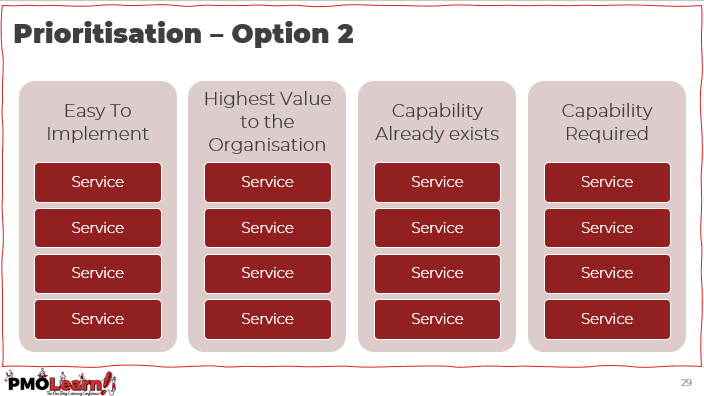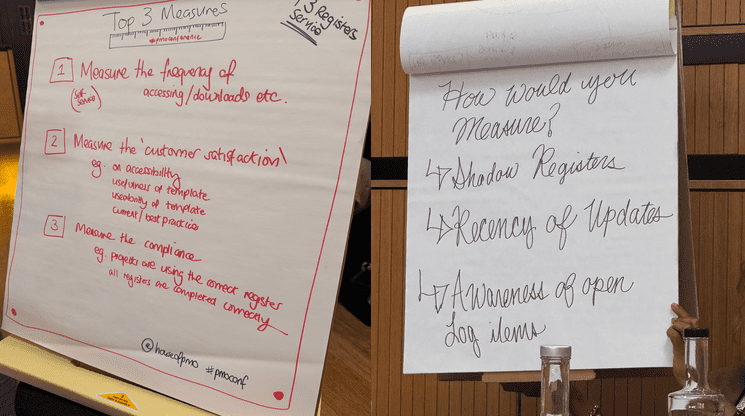Watch back all our PMO Conference sessions
PMO Service Catalogues – The Why, What and How
PMOs can mean many things to many people, so it’s important to define the services we offer, their value to service users, and how they can request these services. This session will take you through developing a comprehensive Service Catalogue using the template being used in the upcoming V2 of the PMO Services Catalogue. It will cover key components such as service descriptions, service levels, and performance metrics, along with providing some hints and tips along the way. We will also discuss best practices for maintaining and updating the Service Catalogue to ensure it remains relevant and effective.
Delegates will leave the session:
- Knowing how to identify the services their PMO could be offering
- Knowing how to put a Service Catalogue together
- Understanding how to demonstrate to Senior Leadership what a Service Catalogue is and the progress that is being made towards having one and why this is important.
You’ll get hands-on with a real-world service example (Maintain P3 Registers), and leave with practical tools and insights you can take back to your own organisation.
We’ll also cover how to communicate the Service Catalogue’s value to senior leaders, and how to show progress in its development – especially if your PMO is still evolving or not traditionally service-based.
Recorded Session
Download the Workbook
Download the WorkbookKey Takeaways
1. What a PMO Service Catalogue is (and isn’t)
What it is: A Service Catalogue is a clearly defined list of what your PMO delivers – services like risk register support, assurance reviews, benefits tracking, governance reporting, and so on. For each service, it outlines what it includes, why it exists, who’s responsible, how it’s measured, and any service-level expectations.
A Service Catalogue is a clearly defined list of what your PMO delivers – services like risk register support, assurance reviews, benefits tracking, governance reporting, and so on. For each service, it outlines what it includes, why it exists, who’s responsible, how it’s measured, and any service-level expectations.
What it isn’t:
-
A to-do list of PMO tasks
-
A list of what people think the PMO should do
-
A one-off document filed away in SharePoint purgatory
Instead, it’s a live, structured way of communicating what the PMO actually does, with purpose, clarity and alignment to business need.
It’s especially powerful when there’s confusion around the PMO’s role or too many ad hoc requests coming in from left, right and centre.
 2. Why it matters – both strategically and operationally
2. Why it matters – both strategically and operationally
At a strategic level, the Service Catalogue:
-
Links your PMO’s effort to organisational priorities
-
Helps justify investment in PMO capability
-
Supports conversations with senior leaders about what the PMO enables
At an operational level, it:
-
Sets expectations with delivery teams, sponsors, and execs
-
Reduces “grey areas” in PMO support
-
Helps allocate PMO resource and manage demand
-
Encourages consistent ways of working across teams
Without one, PMOs risk becoming reactive, overextended, or misaligned with what the business actually values.

Stakeholders may ask for many things but they are not always the services that that they really needed and may not be what we can deliver. You need to take these requests and ask yourself why these services are needed and which ones are really needed.
 3. Why Prioritisation Matters in Building the Service Catalogue
3. Why Prioritisation Matters in Building the Service Catalogue
In the session, we explored the importance of prioritising PMO services as a practical and strategic step in building a Service Catalogue, recognising that not all services can or should be delivered at once, and that focusing on the highest-value, most impactful services first is key to creating a relevant, usable, and sustainable catalogue.
How We Approached Prioritisation in the Session
Two simple but effective options were discussed and used:
Option 1: MoSCoW Method
Participants looked at their list of services and categorised them as:
-
Must Have – essential to the PMO’s purpose or required for compliance/governance
-
Should Have – valuable and widely used, but not critical
-
Could Have – potential future service or only needed in specific cases
-
Won’t Have (for now) – either not suitable for this PMO, or no current need
This method helped PMOs make sense of what to work on first when building out the service entries.
Option 2: Value vs. Effort Matrix
This was a more visual approach:

Participants plotted services on this matrix to identify:
-
Quick Wins (high value, low effort) – a great place to start building confidence and momentum
-
Strategic Investments (high value, high effort) – worth doing, but may need phasing or support
-
Low Value Activities – potential for retirement or consolidation
4. Creating Service Descriptions
The focus was on turning high-level service ideas into clearly defined, structured entries within the PMO Service Catalogue. Participants were guided through the process of articulating:
-
What the service is – a concise and jargon-free explanation
-
Why the service is needed – linking it to decision-making, compliance, or delivery support
-
Why the PMO is best placed to provide it – highlighting objectivity, consistency, or centralised access
-
How the service is delivered – including steps, tools, templates, or processes
-
How it’s measured – whether by stakeholder satisfaction, accuracy, timeliness, or compliance
-
Service levels and tailoring – outlining expectations, variability across projects, and any known limitations
The session also explored ownership and accountability: who provides the service, who owns it, and how it connects to other services. We used a working example – “Maintain P3 Registers” – as a base template and adapted it to our own organisation’s context, making the exercise both practical and relevant. This step was about making the service real – not abstract or theoretical – so others can understand, access, and value it.
5. The Practical Exercise
Take a look at the working example – P3 Registers, [download it here]
The core exercise centred on a sample service – “Maintain P3 Registers”. Working individually or in groups, learners tailored the service description using their organisational context. They considered:
-
What the service does – including the type of registers (risk, issue, dependency, etc.)
-
Why the service exists – linking it to governance, traceability, and decision-making
-
Why the PMO is the right owner – due to its cross-cutting role and consistency
-
Who is responsible – and who else is involved (e.g. RACI considerations)
-
How the service is measured – accuracy, completeness, stakeholder feedback, audit readiness
-
Tailoring needs – based on project size, maturity, or system used
-
Dependencies – e.g., templates, tools like SharePoint or Excel, and governance calendars
The exercise brought to life the challenge of defining something that’s often done informally, highlighting the need for clarity, ownership, and realistic service levels.
“It’s harder than it looks.”
Many participants found this part of the exercise more difficult than expected. While it was fairly straightforward to describe the service and why it exists, defining how to measure its value proved trickier.
People realised that activity ≠ value – just because you do a service doesn’t mean it’s useful or that you’re doing it well. This part of the exercise encouraged a shift in thinking from outputs (“we produce a report”) to outcomes (“that report improved decision-making”).

“We don’t always have the data.”
Some PMOs admitted they don’t currently collect any metrics on the services they provide – or they rely on anecdotal feedback rather than objective data. This was especially true for softer services like stakeholder engagement or facilitation.
It sparked conversations around:
-
Tracking stakeholder satisfaction
-
Defining timeliness and accuracy
-
Using compliance with templates/processes as a basic performance indicator
-
Exploring cost vs benefit in terms of time saved or rework avoided
“We need to ask what ‘good’ looks like.”
One group commented that measurement becomes easier when you know the intended outcome of the service. For example:
-
Is the service aiming to reduce risk?
-
Improve decision speed?
-
Increase consistency across projects?
That clarity helped frame how success could be measured, even if not with hard numbers.
“This will help us have better conversations with leadership.”
There was general agreement that having a few well-thought-through metrics would make it easier to:
-
Justify the PMO’s role
-
Report on progress
-
Support investment in tools or resource
This tied back to the idea of using the Service Catalogue not just internally, but as a strategic communication tool.

 2. Why it matters – both strategically and operationally
2. Why it matters – both strategically and operationally